Comet C/2019 Y4 (ATLAS) discovered in December last year promised a possible great naked eye show as the icy rock’s rate of brightening surprised astronomers around the globe. Forecasts for this coming May suggested that comet ATLAS could become a bright comet indeed reaching magnitudes of anything form +2 to -11. The latter prediction would have made this the most spectacular comet apparition of a generation.
There were always reservations by astronomers around some of these fantastical predictions however. It was widely thought that given the comet is not a newcomer to the solar system and also due to the incredible rate of brightening through the winter, C/2019 Y4 could not sustain such increases in magnitude all the way to perihelion in May. Since mid-March, the rate of brightening had stalled at around magnitude 8 before some indications of a slight dimming through early April. More recent observations however have confirmed our worst fears. Latest observations and images taken by amateur astronomers suggest that the comet’s nucleus is breaking up.
On April 6th, astronomers Quanzhi Ye (University of Maryland) and Qicheng Zhang (Caltech) reported new images of Comet ATLAS, in which the comet’s core appears to be elongating.
These newly-released images from the Ningbo Education Xinjiang Telescope (NEXT) telescope in China suggest that a “major disruption” of the comet’s core is underway…
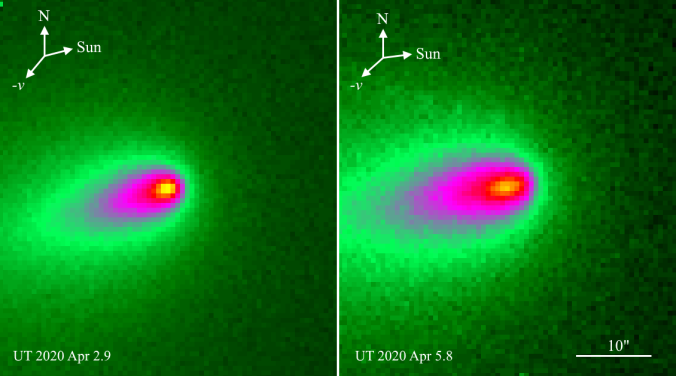
Karl Battams of the Naval Research Lab in Washington DC had said on March 15th:
‘I wouldn’t be surprised to see Comet ATLAS start to fade rapidly and possibly even disintegrate before reaching the sun.’ I very much hope I’m wrong, but Comet Elenin did something similar several years ago, holding lots of promise and then just… fizzling.”
So we were warned. Battams now says “It’s possible that this is the beginning of the end” who went on to explain that not only are we observing this elongation, Comet ATLAS is experiencing non-gravitational forces. Battams says:
“These forces are the result of gases lifting off the comet nucleus and causing the nucleus to move very slightly in the opposite direction–sort of like a jet engine. Most active comets experience this to some degree, but ATLAS’s non-gravitational forces have kicked in very abruptly and are quite strong. This supports a narrative of a small nucleus being pushed very strongly by extreme out-gassing, possibly along with fragmentation.”
However there is still a glimmer of hope. Battams goes on to say that “The frustrating thing about comets is we often don’t know exactly what they’re doing or why they’re doing it. There’s still a chance that Comet ATLAS is just ‘taking a breather’ before another outburst,” says Battams, who then adds… “But I wouldn’t count on it….”
Still visible.. for now
For now, once we are past this full (Super Pink) Moon, Comet c/2019 y4 (ATLAS) is still visible in telescopes headed towards the constellation of Camelopardalis. The unpredictable object then heads in to Perseus and reaching perihelion on 31 May, 2020 at a distance of 0.25 AU from the sun or 23.5 million miles. The comet is also a reasonably easy photographic target which amateur astronomers are encouraged to monitor through THE MEDIUM OF photography.
Comet ATLAS Path Maps
20 March – 28 June
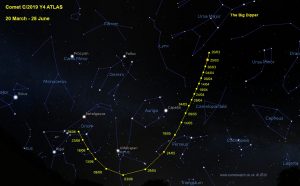
Detailed Chart – March – April 2020
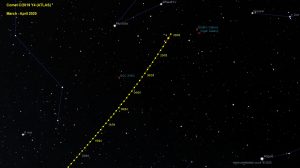
Detailed Chart – 25 April – 20 May
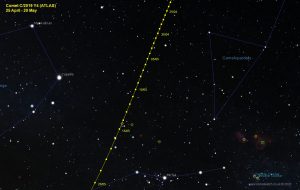
Detailed Chart – 15 May – 29 June (Including Perihelion)
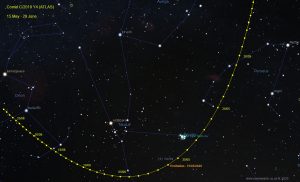

Leave a Reply